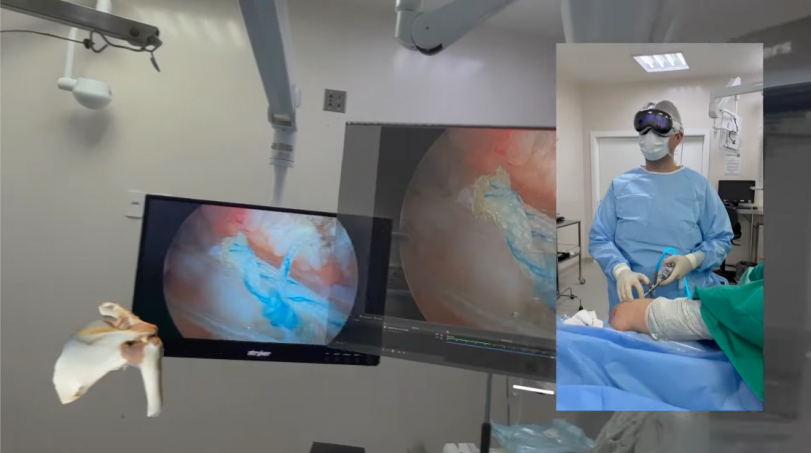Augmented Reality: Advantages, Limitations, and Real-World Applications in Modern Healthcare Practices

Types of Augmented Reality in Healthcare
Augmented Reality (AR) has firmly begun to take place within the surgical domain by emerging as a new approach to augmenting surgical precision, efficiency, and outcomes. AR (augmented reality) technology is becoming increasingly prevalent in healthcare. There are three main types of AR technology that are commonly used in this field.
- Projection-Based (PB) AR
- Video-see-through (VST) Augmented Reality
- Optical-see-through (OST) Augmented Reality
Augmented Reality – Current Use and Future Influence in Healthcare
https://ijisrt.com/assets/upload/files/IJISRT21DEC581.pdf
Projection-Based AR

Projection-based augmented reality (AR) employs projectors to superimpose digital material on physical items in the real world. This provides the user with an augmented reality experience without using a headset or other gear.
Advantages:
Visibility to Multiple Observers: Unlike other AR types, projection-based AR can be viewed by anyone in the operating room without special equipment, facilitating better team coordination and learning opportunities.
Intuitive Interaction: Surgeons can interact more naturally with the patient and the digital information, as it is directly overlaid on the physical world, reducing cognitive load and the potential for error.
Limitations:
Environmental Constraints: The effectiveness of projection-based AR can be diminished by lighting conditions, the complexity of the projection surface, and obstructions, which may affect visibility and accuracy.
Limited Immersion: This method may offer a less immersive experience than VST and OST AR, as the information is not integrated into a three-dimensional view of the surgical field.
Example: AccuVein, a leader in vein visualization technology, utilizes projector-based Augmented Reality (AR) to enhance medical procedures.
Video-see-through (VST) Augmented Reality

Video-see-through (VST) technology is found in mixed reality (XR) devices.
VST AR, a transformative technology, overlays digital content on a live video feed of the natural world, which the surgeon views on a screen or through a headset. This approach revolutionizes the integration of complex datasets, such as CT or MRI scans, with live surgical views, offering a detailed perspective on underlying anatomical structures.
Advantages:
Enhanced Precision: By combining real-time video with preoperative imaging data, surgeons can perform procedures with higher accuracy, especially in minimally invasive surgeries.
Flexibility: VST AR can be implemented on various devices, including headsets and standard monitors, allowing adaptability to different surgical setups and preferences.
Limitations:
Potential for Disorientation: The indirect view of the surgical field through a screen may require an adjustment period for surgeons to become proficient, potentially affecting hand-eye coordination initially.
Dependency on Equipment: The quality of the augmented experience heavily relies on the camera and display technology, which may limit resolution and field of view.
(VST) AR, video-see-through
Example: Apple Vision Pro, Meta Quest 3.
Optical-see-through (OST) Augmented Reality

Optical-see-through (OST) Augmented Reality projects digital images onto transparent lenses of head-ups displays (HMDs), such as Google Glass or the Microsoft HoloLens. This allows surgeons to simultaneously see the physical environment and relevant digital information without looking away from the surgical site.
Advantages:
Immersive Experience: OST AR offers a highly immersive experience, with digital content seamlessly integrated into the surgeon’s field of view, enhancing situational awareness and precision.
Hands-free Operation: Many OST AR devices support voice commands and gesture recognition, allowing surgeons to maintain sterility and focus while interacting with digital content.
Limitations:
Limited Field of View: Some users may find the field of view restricted, limiting the visibility of both the surgical site and augmented information.
Device Comfort and Usability: Prolonged use of head-mounted displays can be uncomfortable for some users, and there may be a learning curve associated with operating these devices efficiently.
Example: Google Glass, and the Microsoft HoloLens
The integration of AR in surgery presents a promising frontier for enhancing surgical performance and patient outcomes. Each AR type—projection-based, VST, and OST—offers unique benefits and faces specific challenges. The choice of AR technology depends on the surgical procedure’s particular needs, the surgical team’s preferences, and the technological infrastructure available. As AR technology continues to evolve, its adoption in orthopedic surgery is expected to increase, driven by ongoing improvements in accuracy, usability, and immersive experiences.
Sources:
Hu, X., Baena, F., & Cutolo, F. (2021). Head-Mounted Augmented Reality Platform for Markerless Orthopaedic Navigation. IEEE Journal of Biomedical and Health Informatics, 26, 910-921. https://doi.org/10.1109/JBHI.2021.3088442.
Mamone, V., Ferrari, V., Condino, S., & Cutolo, F. (2020). Projected Augmented Reality to Drive Osteotomy Surgery: Implementation and Comparison With Video See-Through Technology. IEEE Access, 8, 169024-169035. https://doi.org/10.1109/ACCESS.2020.3021940.
Li, R., Han, B., Li, H., Ma, L., Zhang, X., Zhao, Z., & Liao, H. (2023). A Comparative Evaluation of Optical See-through Augmented Reality in Surgical Guidance.. IEEE transactions on visualization and computer graphics, PP. https://doi.org/10.1109/tvcg.2023.3260001.
